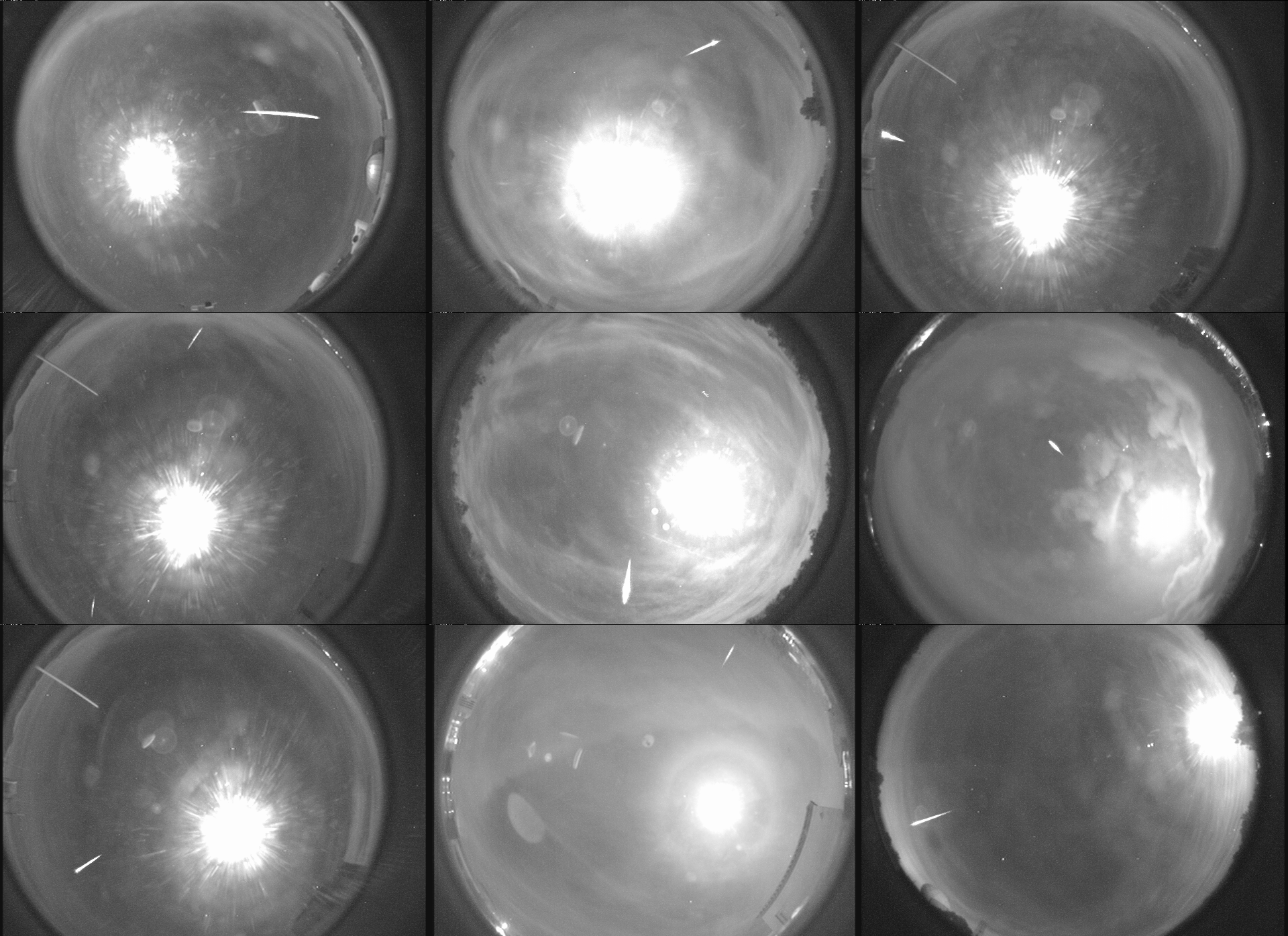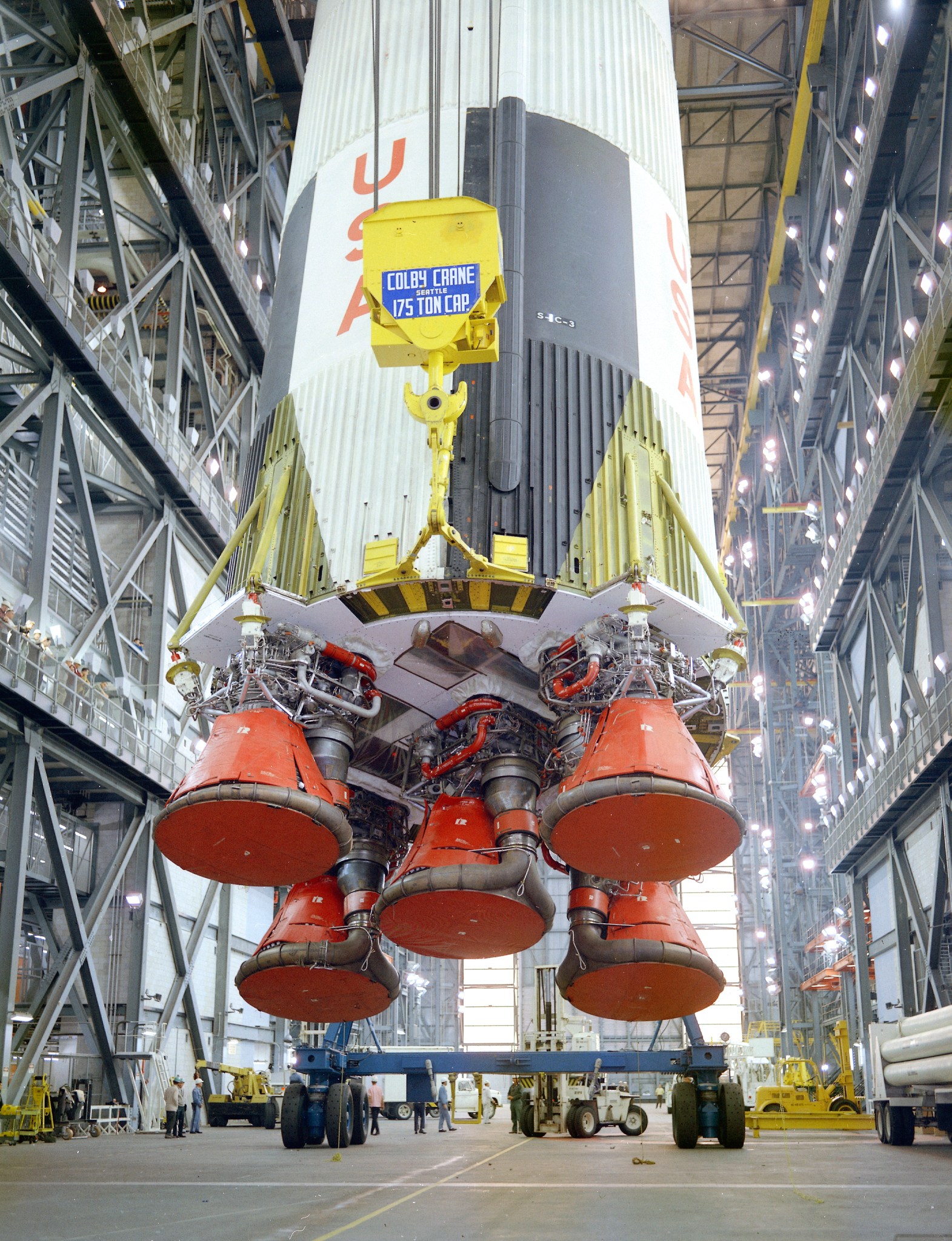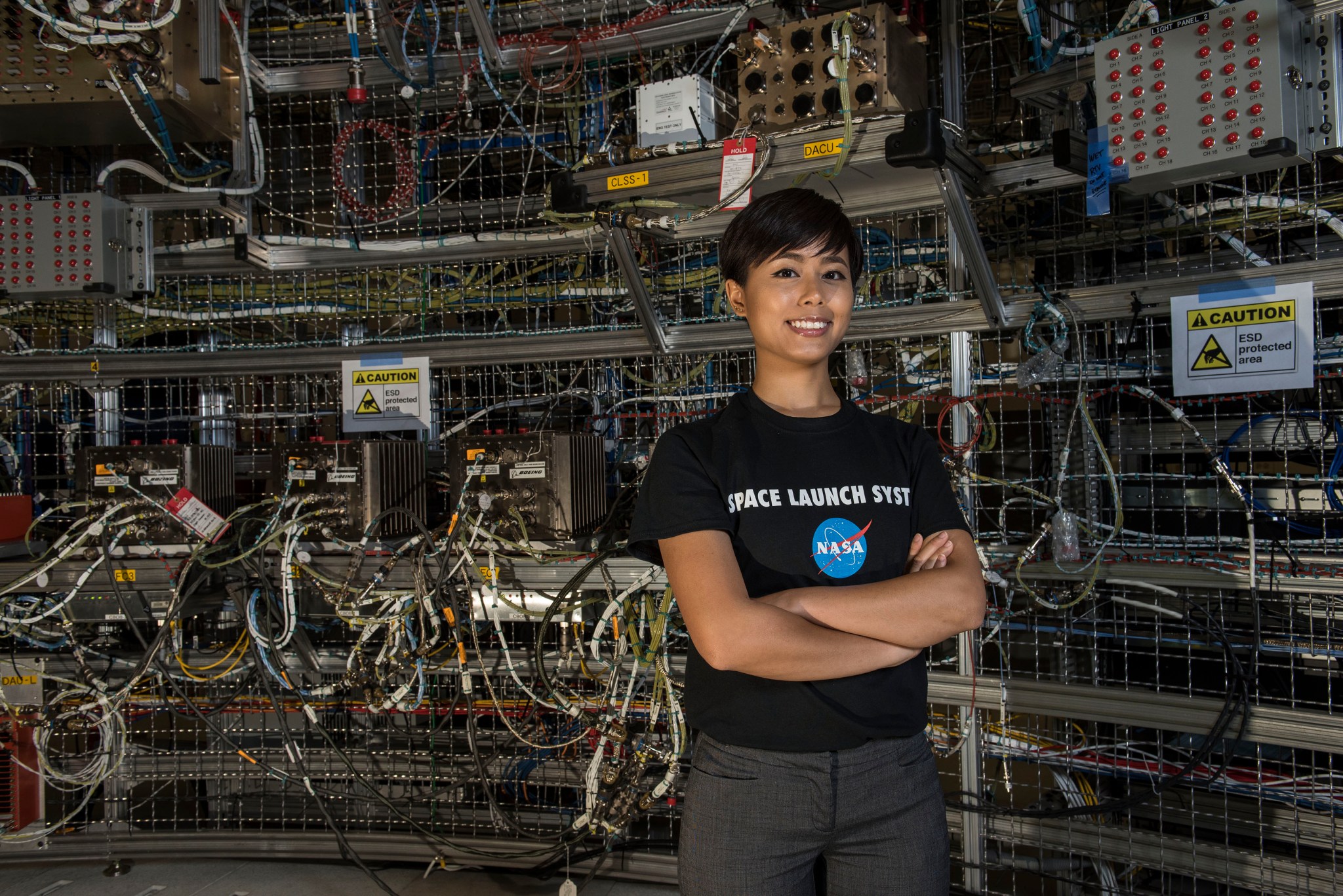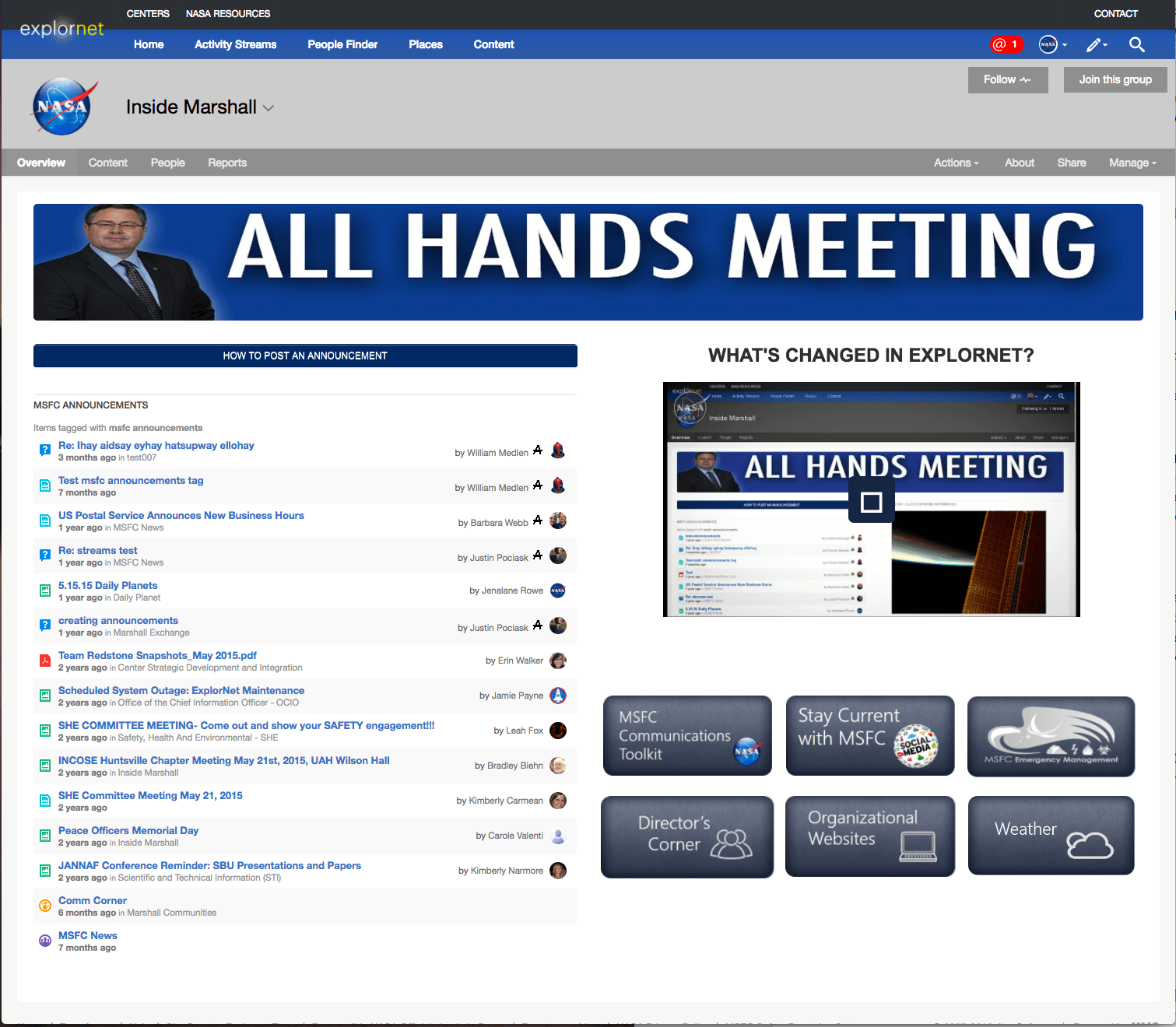In This Week’s Star
- Director’s Corner: Punctuating the Year
- Faces of SLS: Ratana Meekham
- Scientists Studying Future of Life Support on Space Station
- Video Explores How Working with Gravity Will Help on Journey to Mars
- Cosmic ‘Winter’ Wonderland
- Your Clicks Create a New Look for Inside Marshall
- Annual Geminid Meteor Shower Marks the Holiday Season
- This Week in NASA History: First Crewed Saturn V Mission Launches — Dec. 21, 1968
- Obituaries
Director’s Corner: Punctuating the Year
With the New Year just a few days away, I want to talk about a resolution. Not a New Year’s resolution, but the resolution of another great year here at Marshall. The New Year is about the promise of tomorrow, but what better way is there to position yourself for the future than by seizing the momentum of today?
A few weeks ago I called on the NASA Marshall Space Flight Center family to make a final push to reach our 2016 Combined Federal Campaign goal and you responded the way you always do — by exceeding expectations. Marshall didn’t just meet its CFC goal of $608,000, we beat our goal. You recognize the power of public service and the responsibility we share in giving back to the community. Beating our 2016 CFC goal is about more than stepping up to the challenge, it’s about showing that Marshall cares about the people, organizations and institutions that make the Tennessee Valley a great place to live and work.
Our commitment to the community is a great example of what makes Marshall a special place — we understand that what we do is more than just a job. Marshall focuses on the big picture — we have and continue to pave the way for historic milestones in space exploration; our work advances scientific progress and discovery. But, Marshall doesn’t forget about those things that are closer to home. We give back and stay engaged with the community around us. This is why NASA topped the ranking of the “Best Places to Work in Federal Government” for the fifth consecutive year — because it is much more than just a place to work.
What a way to punctuate the holiday season and the year itself — with an exclamation mark. Time and again, the men and women of Marshall do things that simply amaze me.
Soon we’ll need to roll up our sleeves and tackle the challenges of a new year, but if you have an opportunity to celebrate the holidays, or just spend time with your loved ones, I hope you can make the most of it.
Faces of SLS: Ratana Meekham
Installing 5,000 miles of cable to test avionics for the world’s most powerful rocket, NASA’s Space Launch System? Not a problem for Ratana Meekham and her fellow technicians at NASA’s Marshall Space Flight Center.
I’m an electrical integration technician at Qualis Corp., supporting Jacobs ESSSA on the NASA Engineering & Science Services and Skills Augmentation contract. I’m part of a team that assembles the core-stage avionics and hardware on the massive, half-ring structure used by technicians in Marshall’s Software Integration Testing Facility to assess avionics for the world’s most powerful rocket, the Space Launch System.
Avionics will enable the vehicle navigation, communications and other functions critical to human spaceflight, so we rigorously subject it to simulated sensor failures, temperature fluctuations and many other issues future SLS crews might encounter. The system is then further refined to ensure it is “go for launch.” I’m so proud of our team! To date, we’ve installed roughly 5,000 miles of cables and wired, custom-built panels for avionics testing in this high-tech simulation lab.
My family emigrated from Laos to California; I was born there, in the city of Stockton. We later moved to Huntsville to start a new life. To gain the experience I knew I would need for my career, I studied precision machining in high school. Immediately after graduation, I joined the Jacobs ESTS contract as a technician to polish hardware for the joint Russian-NASA Astronomical Roentgen Telescope X-ray Concentrator. Part of the Spectrum-Roentgen-Gamma mission, it is set for launch in 2017 to conduct high-energy astrophysics research.
I love constantly learning new things, and I’m happy to be part of the team dedicated to the success of SLS!
NASA’s Marshall Space Flight Center manages the SLS Program for NASA.
Scientists Studying Future of Life Support on Space Station
An investigation underway this week on the International Space Station — the round-the-clock orbiting laboratory working on the discoveries to improve life on Earth — will improve the lives of those who will eventually travel beyond Earth orbit.
NASA astronaut Peggy Whitson has installed a camera system on the space station to record science operations for the Packed Bed Reactor Experiment, an investigation that may help build better space vehicles. The experiment studies the behavior of gases and liquids as they simultaneously flow through the same column that has been filled with fixed porous media. This is important for the study of many chemical and biological processing systems, as well as numerous geophysical applications.
Water-recovery systems, fuel cells and other equipment on the station use packed bed reactors, but none are designed to handle both liquid and gas at the same time. Scientists are working to understand how a packed bed two-phase flow would work in microgravity. The results of the experiment could help scientists design more efficient and lightweight thermal management and life support systems that use less energy, benefiting not only the space station, but future Mars missions as well.
The Payload Operations Integration Center at NASA’s Marshall Space Flight Center serves as “science central” for the space station, working 24/7, 365 days a year in support of the orbiting laboratory’s scientific experiments. To learn more about the Packed Bed Reactor Experiment, check out this interview with the study’s principal investigator. Click here for the latest on scientific investigations on the space station.
Video Explores How Working with Gravity Will Help on Journey to Mars
How does working with gravity, instead of against it, help NASA’s Space Launch System rocket escape the gravity confines of Earth? The fourth installment of the video series “No Small Steps” explains this and how orbiting is really just the art of constantly falling sideways. Host Stephen Granade explains how rockets deliver spacecraft into Earth orbit, and how that process resembles and differs from a trajectory to Mars. (NASA/MSFC)
Cosmic ‘Winter’ Wonderland
Although there are no seasons in space, this cosmic vista invokes thoughts of a frosty winter landscape. It is, in fact, a region called NGC 6357 where radiation from hot, young stars is energizing the cooler gas in the cloud that surrounds them.
This composite image contains X-ray data from NASA’s Chandra X-ray Observatory and the ROSAT telescope (purple), infrared data from NASA’s Spitzer Space Telescope (orange), and optical data from the SuperCosmos Sky Survey (blue) made by the United Kingdom Infrared Telescope.
Located in our galaxy about 5,500 light years from Earth, NGC 6357 is actually a “cluster of clusters,” containing at least three clusters of young stars, including many hot, massive, luminous stars. The X-rays from Chandra and ROSAT reveal hundreds of point sources, which are the young stars in NGC 6357, as well as diffuse X-ray emission from hot gas. There are bubbles, or cavities, that have been created by radiation and material blowing away from the surfaces of massive stars, plus supernova explosions.
Astronomers call NGC 6357 and other objects like it “HII” (pronounced “H-two”) regions. An HII region is created when the radiation from hot, young stars strips away the electrons from neutral hydrogen atoms in the surrounding gas to form clouds of ionized hydrogen, which is denoted scientifically as “HII.”
Researchers use Chandra to study NGC 6357 and similar objects because young stars are bright in X-rays. Also, X-rays can penetrate the shrouds of gas and dust surrounding these infant stars, allowing astronomers to see details of star birth that would be otherwise missed.
A recent paper on Chandra observations of NGC 6357 by Leisa Townsley of Pennsylvania State University in State College appeared in The Astrophysical Journal Supplement Series and is available online. NASA’s Marshall Space Flight Center manages the Chandra program for NASA’s Science Mission Directorate. The Smithsonian Astrophysical Observatory in Cambridge, Massachusetts, controls Chandra’s science and flight operations.
Your Clicks Create a New Look for Inside Marshall
By Jena Rowe
The New Year is coming which means resolutions are upon us bringing decisions to exercise more, take a trip you’ve always dreamed of, quit bad habits or create new good ones. For NASA’s Marshall Space Flight Center it means updating Inside Marshall — the employee intranet presence on ExplorNet.
The Office of the Chief Information Officer will be transitioning ExplorNet to serve as an agency-wide platform on Dec. 29. “As part of on-going agency efforts to foster multi-center collaboration, ExplorNet will assist with consolidating applications and reducing duplication within tools,” said John McDougle, deputy director of Marshall’s Office of the Chief Information Officer. “The idea is for the ExplorNet application to create a central location where each NASA employee can access information regarding NASA’s mission and capabilities.”
Because ExplorNet is moving to an enterprise tool, Inside Marshall will now live under the agency’s umbrella. “Our goal is to make it as easy as possible for the Marshall team to stay informed,” said Johnny Stephenson, director of the Office of Strategic Analysis & Communications. “We have worked with our partners in OCIO to make updates to Inside Marshall based on data that reflects how our workforce accesses information and enhances employee communications.”
OCIO and OSAC worked to gather website heat-mapping data over the course of several months. Website heat-mapping data provides a graphical representation of the content users click the most. Based on this information, ExplorNet and Inside Marshall will be updated to more effectively meet the needs of users making frequently used information more accessible.
What’s New on Inside Marshall:
Image of the Day: In addition to the scrolling banners currently displayed on Inside Marshall, users will also stay visually connected with the work happening at Marshall through an Instagram image of the day. Occasionally this content will also be updated with videos such as This Week at NASA and live feeds of Marshall all-hands meetings.
Follow Inside Marshall: Users will have the ability to subscribe to an email update when content is added or significantly modified on Inside Marshall. Some content updates included in the emails are NASA and Marshall news found in the Daily Planet and center-wide announcements.
Relevant Drop-Down Menus: Inside Marshall heat-mapping data revealed that users most frequently used existing drop-down menus to access content. Based on this information, the drop-down menus have been edited to reflect the most used options making things more easily found to get work done and connect with fellow team members.
Browser Homepage: Because ExplorNet is moving to an enterprise tool, some users may need to update their browser’s homepage to reflect the new Inside Marshall web address due to this new structure. Users who primarily access the Internet via Internet Explorer will not be affected by this change. However, users who primarily access the Internet via any other browser such as Safari or Google chrome will.
For any questions, please contact Jenalane Rowe or Barbara Jo Webb. You may also visit the Employee Communications blog to watch a short video highlighting navigational tips for Inside Marshall.
Rowe, an ASRC Federal/Analytical Services employee, supports the Office of Strategic Analysis & Communications.
Annual Geminid Meteor Shower Marks the Holiday Season

Several Geminid meteors are photographed streaking across the sky by special cameras managed at NASA’s Marshall Space Flight Center. The Geminid shower is so named because its meteors appear to radiate from the Gemini constellation. This annual winter event begins in early December and lasts a couple of weeks, with meteors typically seen Dec. 4-17, peaking near Dec 13-14. To highlight this astronomical shower and engage fans across the world, meteor experts from NASA’s Meteoroid Environment Office answered fan questions during a Reddit Ask-Me-Anything event Dec. 12. (NASA/MSFC)
This Week in NASA History: First Crewed Saturn V Mission Launches — Dec. 21, 1968

This week in 1968, Apollo 8, the first crewed Saturn V launched from NASA’s Kennedy Space Center on Dec. 21, 1968. Here, the S-IC stage is being erected for final assembly of the Saturn V launch vehicle in Kennedy’s Vehicle Assembly Building. NASA’s Marshall Space Flight Center designed, developed and managed the production of the Saturn V rocket that powered the Apollo and Skylab missions. Today, Marshall is developing NASA’s Space Launch System, the most powerful rocket ever built that will be capable of sending astronauts deeper into space than ever before, including to an asteroid and Mars. The NASA History Program is responsible for generating, disseminating, and preserving NASA’s remarkable history and providing a comprehensive understanding of the institutional, cultural, social, political, economic, technological, and scientific aspects of NASA’s activities in aeronautics and space. For more pictures like this one and to connect to NASA’s history, visit the History Program’s webpage. (NASA)
Obituaries
Everett R. Teague, 87, of Huntsville, died Dec. 17. He retired from the Marshall Center in 1995 as an aerospace engineer. He is survived by his wife, Sylvia Teague.





























